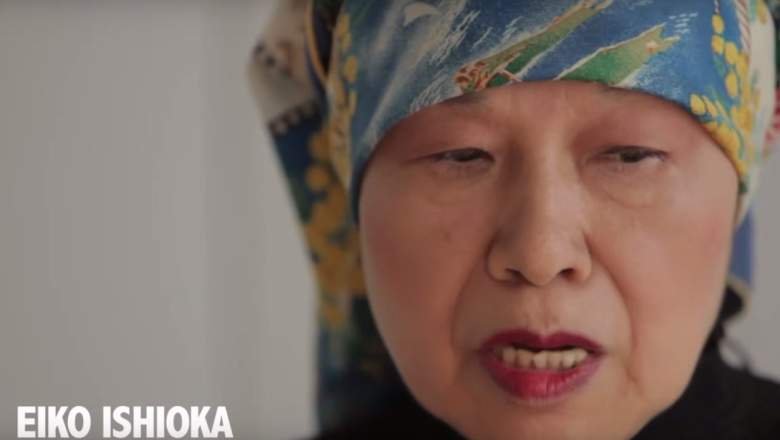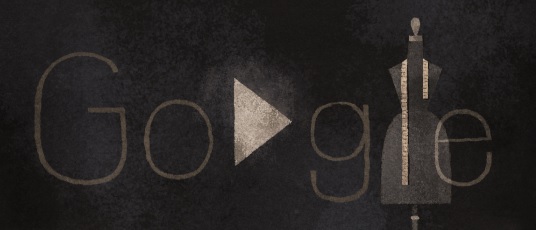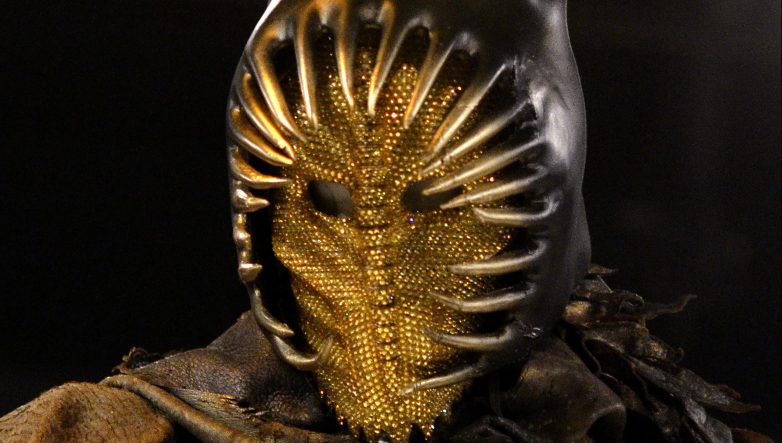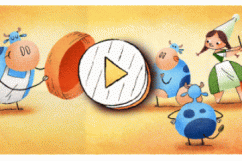
Eiko Ishioka, the Oscar-winning costume designer, is the subject of the July 12 Google Doodle. She would be celebrating her 79th birthday today.
Ishioka was born in Tokyo on July 12, 1938 and died on January 21, 2012 at age 73.
“Earning her an Oscar, a Grammy, and two Tony nominations, Eiko Ishioka’s work had a way of taking center stage no matter the medium,” Google said. “From print ads and album covers to costumes for film, theater, and the Olympics, the iconic Japanese designer did it all during her decades-long career — often unlike anyone before.”
The doodle features designs for Tarsem Singh’s 2006 film The Fall with Lee Pace.
Here’s a look at Ishioka’s life and career.
1. Ishioka & Francis Ford Coppola Knew Each Other for 2 Decades Before He Hired Her for ‘Bram Stoker’s Dracula’

GoogleThe Eiko Ishioka Google Doodle.
Ishioka‘s first film experience was on Paul Schrader’s Mishima: A Life in Four Chapters, a 1985 film about writer Yukio Mishima. In 1991, she worked on Closet Land, which starred Alan Rickman.
Her third film was Francis Ford Coppola’s Bram Stoker’s Dracula, which earned her an Academy Award for Best Costume Design.
Coppola first met Ishioka almost 20 years before he hired her to work on Dracula, for which she created unique costume designs to make the film stand out when compared to other horror films. Oscars.org notes that Ishioka also designed elegant Japanese posters for Apocalypse Now and designed the book Notes: On the Making of Apocalypse Now. Coppola was also the executive producer on Mishima.
Ishioka and Coppola also worked together on a 1987 episode of Faerie Tale Theatre that he directed.
According to the Oscars, Coppola described Ishioka as “a weirdo outsider with no roots in the business,” which is exactly why he liked working with her.
2. Ishioka Made 4 Films With Director Tarsem Singh, Including ‘The Cell’ & ‘Mirror Mirror’
While Ishioka could have used her Oscar win to launch a career in films, she only chose a handful of movies to work on for the rest of her life. The only director she worked with more than once was Indian filmmaker Tarsem Singh. She designed the costumes for his four most well-known projects, The Cell (2000) with Jennifer Lopez; The Fall (2006); Immortals (2011); and Mirror Mirror (2012). She earned a posthumous Oscar nomination for Mirror Mirror.
After her death, Singh said Ishioka’s goal for the Mirror Mirror costumes was to “evoke a true fairy tale.” Every costume for Ishioka had to say something about the character wearing it.
“She was not well during the movie; she was undergoing chemotherapy. But Eiko had only two gears: full-out or no gear at all. Her work kept her alive—it was her reason for being,” Singh told W Magazine.
“Eiko would say that red is the most difficult color,” Singh told W Magazine. “But in many ways, red was Eiko: strong, intense, brilliant.”
In a 2011 V Magazine interview, Ishioka explained why she liked working with the director:
“Tarsem as a director has given me guidance… I feel like I have a freedom to build ideas based on his guidance… Hollywood is a good example of dictatorship. Hierarchy is very important. It doesn’t matter if I am working under a general and I say ‘I don’t like it, I don’t like it, I don’t like it.’ He should be able to carry on with his own vision. Luckily, Tarsem and I find a consensus. Mostly it’s a success.”
3. She Designed the Tony-Nominated Costumes for ‘Spider-Man: Turn Off The Dark’
Ishioka’s work in show business went far beyond just the movies. She also designed costumes for the stage. In 1988, she earned Tony nominations for costume and scenic design for the Broadway play M. Butterfly.
In 2012, she earned a nomination for designing the costumes in the troubled Spider-Man: Turn Off The Dark musical. Although the show earned mixed reviews, the design was still praised. Two months after the show closed in 2014, The Smithsonian even added the Spider-Man costume to its collection.
“It’s so iconic in the way it looks,” Dwight Bowers, National Museum of American History curator of culture and the arts, said in a statement. “People will immediately recognize it.”
The costume was designed so carefully that Bowers went through several mannequins before finding one it would fit.
“The costume had to have some stitching and sewing done to it before it got onto the mannequin; the conservator supervising us; and then, me, with whatever muscles I’ve got, to pull it on,” Bowers said. “It took a lot of struggling.”
Ishioka also worked in the music world, winning a Grammy for designing the artwork for Miles Davis’ 1986 album Tutu. She also directed Bjork’s “Cocoon” music video.
4. She Was the Director of Costume Design for the 2008 Beijing Olympics Opening Ceremony
Ishioka also worked on two Olympics. For the 2002 Salt Lake City Winter Games, she designed the outerwear for Canada, Spain, Switzerland and Japan. She worked with Descente and @radical.media to design the outfits, which was a unique challenge for her.
“I thought about the camera on the athletes as they were holding up a gold medal,” she told the New York Times in 2002. “It’s the same attitude I had designing ‘Dracula’ or ‘The Cell.’ The goal is to thrill the audience.”
In 2008, she was called to work on the Beijing Summer Olympics, designing the costumes for the opening ceremony.
“The Beijing Olympics were a completely different world from Greek mythology, which is based on a story,” she told V Magazine. “The process was incredible because I went to the Metropolitan Museum to look at sculpture. A [late 19th-century] helmet mask from Burkina Faso inspired me very strongly, so I cooked myself different versions of the original design. I would draw about ten different drawings, then Tarsem and I would discuss it many times until we finally reached a direction.”
5. Ishioka Died of Pancreatic Cancer in January 2012
On January 21, Ishioka’s life was sadly cut short after a battle with pancreatic cancer, her studio manager, Tracy Roberts, told the New York Times. Her death came just two months before Mirror Mirror‘s release.
Ishioka’s parents encouraged her to pursue a career in the arts. Her father was a graphic designer, and she attended the Tokyo National University of Fine Arts and Music. While there, she decided that she wanted to be a graphic artist, although her father told her that would be difficult. According to her Times obituary, she ignored her father’s warnings and landed a job at Shiseido, the cosmetics company.

GettyA unique design by Eiko Ishioka on display at the FIDM Museum in Los Angeles in 2012.
By the early 1970s, Ishioka had her own firm and built a reputation for creating daring advertising that pushed boundaries in Japan. Her best-known work during the 1970s was for Parco, a shopping chain. She famously designed a Parco commercial that ran 90 seconds and just shows Faye Dunaway peeling a hard-boiled egg. It didn’t even include images of products Parco sold.
Ishioka was survived by her husband, Nicholas Soultanakis, whom she married a year before her death. She was also survived by her mother, two brothers and a sister.

